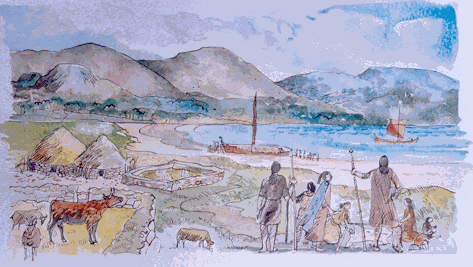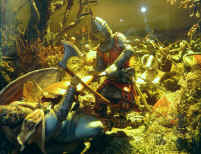
Norse Invaders
The first Vikings to settle in south-east Sutherland came from Norway and probably arrived in the area c.850 AD by way of Orkney and Caithness. The creation of the Earldom of Orkney by King Harald Harfagri of Norway led to increased Viking activity in Sutherland (the ‘Southern land’ of the Earldom of Orkney) as the new earls sought to consolidate their hold on the northern mainland of Scotland.
 From the time of the arrival of the Vikings in the middle of the 9th century through to the building of Dornoch Cathedral during the 1220s, south-east Sutherland was the site of numerous raids and skirmishes between the local Pictish tribes and the Norsemen.
From the time of the arrival of the Vikings in the middle of the 9th century through to the building of Dornoch Cathedral during the 1220s, south-east Sutherland was the site of numerous raids and skirmishes between the local Pictish tribes and the Norsemen.
One Viking warlord may have lingered in Dornoch longer than he intended. The Orkneyinga Saga tells how Sigurd the Powerful ruthlessly tricked his enemy Maelbrighte in 895, killing him and forty of his men. As Sigurd rode home in triumph with Maelbrighte's head strapped to his saddle, he gashed his leg on the dead man's tooth. The wound was fatal and Sigurd the Powerful was buried, says the saga 'in a mound on the bank of the River Oykell'.
The location of Sigurd's grave is still unknown, but some experts believe it is in Dornoch parish. The River Oykell flows into the sea through the Dornoch Firth and just at the mouth of the firth lies Cyderhall Farm which, in the 13th century, was known as Syvardhoch - or the 'howe (burial mound) of Sigurd'.
Gradually violence gave way to peaceful co-existence as the Vikings began to settle in the area, particularly on the fertile coastal strip of land around the Dornoch Firth, and marry into local families. The Viking presence in the area is indicated by a number of local place-names, notably Embo, Skibo and Skelbo (-bol means a ‘large farm on a prime site’).
The role of the Scottish kings
When the Scottish kings began to extend their authority northwards from the 12th century onwards, the Dornoch Firth effectively marked the border between the Kings of Scotland and the Norse Earls. Violence was still common in this frontier country, and although Scots and Norsemen shared the same Christian beliefs, the latter were no respecters of the dignity and sanctity of the Church and its servants – particularly when the Church was viewed by the Norse Earls as a tool of the Scottish Kings designed to extend their authority over Sutherland and Caithness.
David I (1084-1153) probably founded the Diocese of Caithness during the 12th century, and the seat of the diocese was at Halkirk in Caithness, an area effectively outside the control of the Scottish Kings. This lack of authority became evident when two successive Bishops, John and Adam, were attacked by local people: Bishop John was blinded and maimed, while his successor was brutally murdered and roasted in his own kitchen. Although royal retribution was swift and terrible, the attacks prompted Adam’s successor, Gilbert de Moravia to remove the seat of the diocese from Halkirk to the relative safety of Dornoch.
The Battle of Embo

Some doubts remain as to the exact date of this battle: tradition suggests the 1240s, but more reliable recent evidence places the battle in the 1260s. The battle took place after a party of Danes landed at Little Ferry and encamped near Embo. The Earl of Sutherland asked Richard de Moravia (Gilbert’s brother who had been given Skelbo Castle by him in 1235) to engage the Danes and hold them in check until he assembled a strong enough force to come to Richard’s aid. The plan worked, and the Danes were routed on the arrival of the Earl. During the battle Richard was killed and Earl William reputedly slew the Danish leader with the leg of a horse, an incident that accounts for the horseshoe on Dornoch’s present coat-of-arms. After the battle the Earl arranged for Richard de Moravia’s burial in Dornoch Cathedral, where the remains of his damaged sarcophagus can still be seen.

